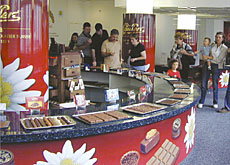Unwrapping the secrets of Swiss chocolate

Switzerland is a nation of chocolate-lovers. According to 2001 figures, the Swiss ate more chocolate per person than anywhere else in the world.
They each munched their way through more than ten kilogrammes of the stuff, with their nearest rivals, the Austrians, managing only 9.1kg.
Satisfying the Swiss sweet tooth is therefore a serious business worth an estimated SFr828 million per year.
Ever since the 19th century, many entrepreneurs have recognised there is money to be made from chocolate.
The country boasts the likes of Phillipe Suchard and François-Louis Cailler, who redefined how chocolate was made, and Charles-Amédée Kohler, who invented hazelnut chocolate.
Indeed many of them gave their names to companies that survive to this day.
Swiss inspiration
But arguably the most influential chocolate pioneer was Daniel Peter, who like Cailler came from Vevey in western Switzerland.
Peter invented milk chocolate in 1875 and established Switzerland as a chocolate-making centre “par excellence”.
Peter looked to the Swiss countryside for inspiration and decided to take advantage of Switzerland’s “home-grown” raw materials.
“Milk is abundant. As you know there are many cows making a lot of milk in Switzerland,” explains Christoph Stettler, a chocolate factory director.
“Therefore Peter tried to find new chocolate recipes which included milk. Dark chocolate is bitter and was not so appealing to the Swiss, who like sweet things.”
It was a slow process, but Peter finally discovered that if milk was condensed it could easily be added to chocolate.
His invention made chocolate more nutritious and far sweeter. It was an instant hit, first with the Swiss and then with chocolate-lovers everywhere.
Nowadays milk chocolate production in Switzerland outstrips dark chocolate production many times over.
Chocolate factory
One of the foremost producers of Swiss chocolate is the Swiss multinational, Nestlé, which owns the Cailler brand produced at a factory in Broc in the region of Gruyère.
Even though the area is famed for its cheese, the only smell in the air around Broc is that of melted chocolate.
The factory is open to the public from May until October and every year 50,000 chocoholics pour through the doors to find out how chocolate is made and to sample the end results.
The tour is free and covers all aspects of chocolate making from cocoa bean to chocolate bar.
Visitors learn that there are four main ingredients in milk chocolate: cocoa, cocoa butter, sugar and condensed milk; and three ingredients in dark chocolate: cocoa, cocoa butter and sugar.
Six-stage process
The manufacturing process is a six-stage affair, which begins with the roasting of cocoa beans to separate cocoa from cocoa butter. The beans are imported from as far afield as the Ivory Coast and Ghana.
Next comes the mixing process where all the raw ingredients are bound together, melted, cooled and then pulverised into a powder.
These are then rolled in big machines to refine the tiny particles. The smaller the powder grains, the better the taste.
The powder is then whizzed around in big metal drums for a minimum of 24 hours.
The friction in the drums raises the temperature of the powder and melts all the ingredients together – a process known as conching, which was invented by another Swiss, Rodolphe Lindt.
Dark chocolate is conched for around 48 hours, and milk chocolate for 24 hours – the longer the conching time, the better the quality of chocolate.
The gloopy mixture is then pumped into moulds, cooled and packaged.
Handmade vs manufactured
One of the most striking features of the factory is that it is spotlessly clean and totally mechanised right up until the moulding stage.
It seems that the idea of Swiss chocolate being handmade simply isn’t true – an impression shared by one of the visitors.
“The factory tour was interesting but a bit strange. There weren’t that many people, but there were loads of machines,” said Martin Jenni from Basel.
Handmade or not, the fervour with which the visitors tuck into the tasting tables at the end of the tour, shows that the Swiss taste for chocolate shows no signs of slowing down.
swissinfo, Sally Mules
The Swiss eat 10.2 kilogrammes of chocolate per person per year
In 2001 the domestic chocolate market was worth SFr828 millio
Cailler is the number one Swiss brand of chocolate
The Cailler factory in Broc first started producing chocolate in 1898.
It was set up by François-Louis Cailler, a chocolate-making pioneer from Vevey who needed bigger premises.
Cailler became part of Nestlé in 1929, and in 2001 the factory produced 16,525 tons of dark, milk and white chocolate for the domestic and export market.

In compliance with the JTI standards
More: SWI swissinfo.ch certified by the Journalism Trust Initiative








You can find an overview of ongoing debates with our journalists here . Please join us!
If you want to start a conversation about a topic raised in this article or want to report factual errors, email us at english@swissinfo.ch.